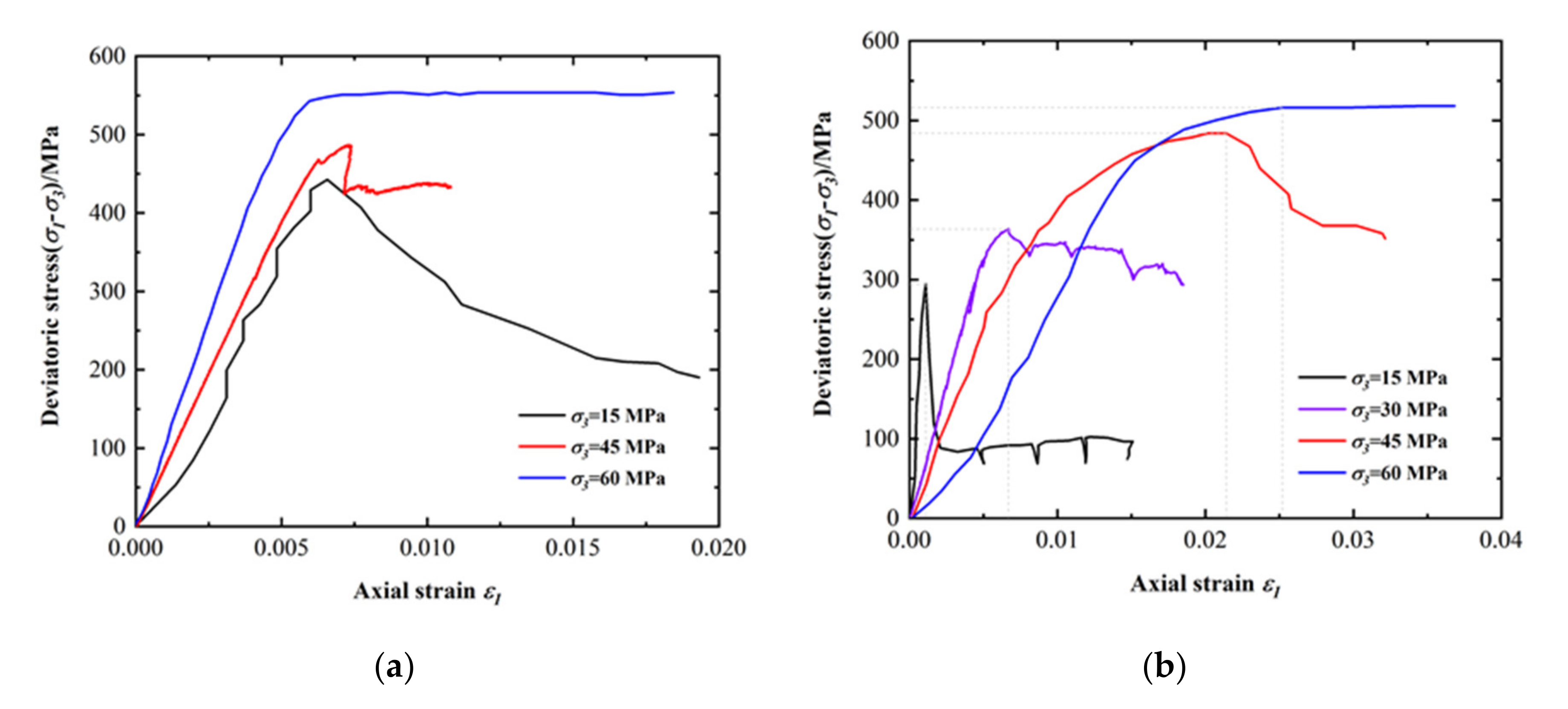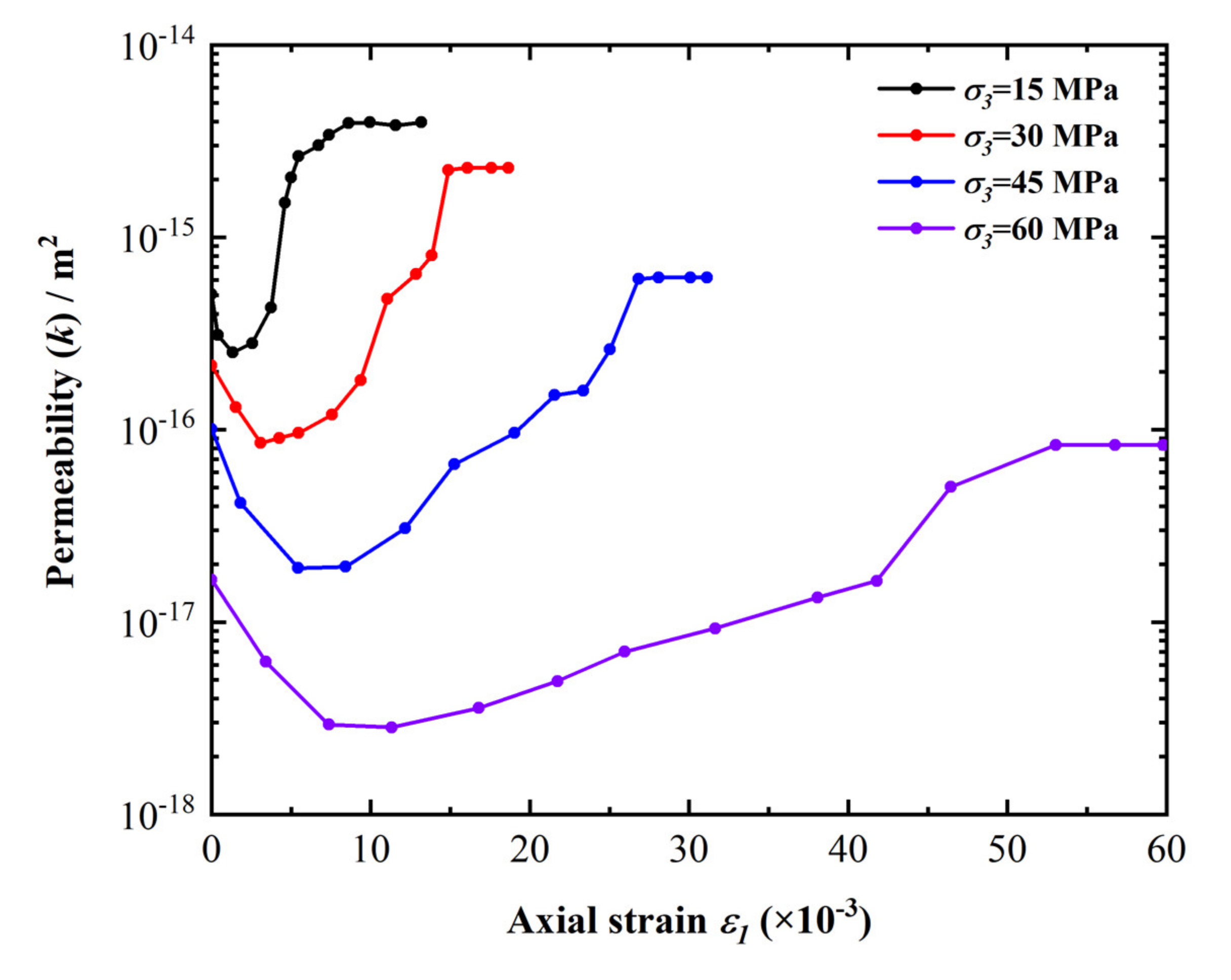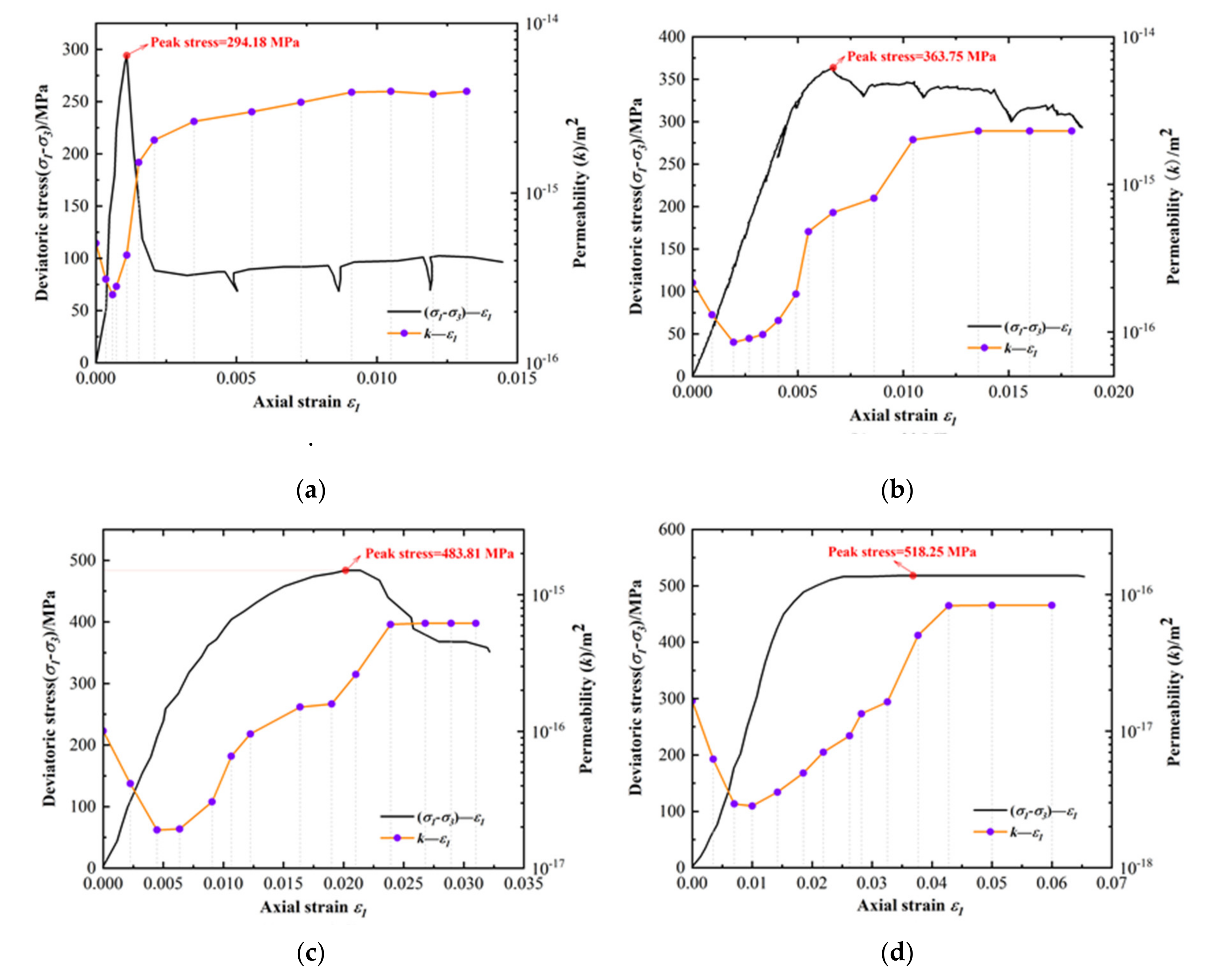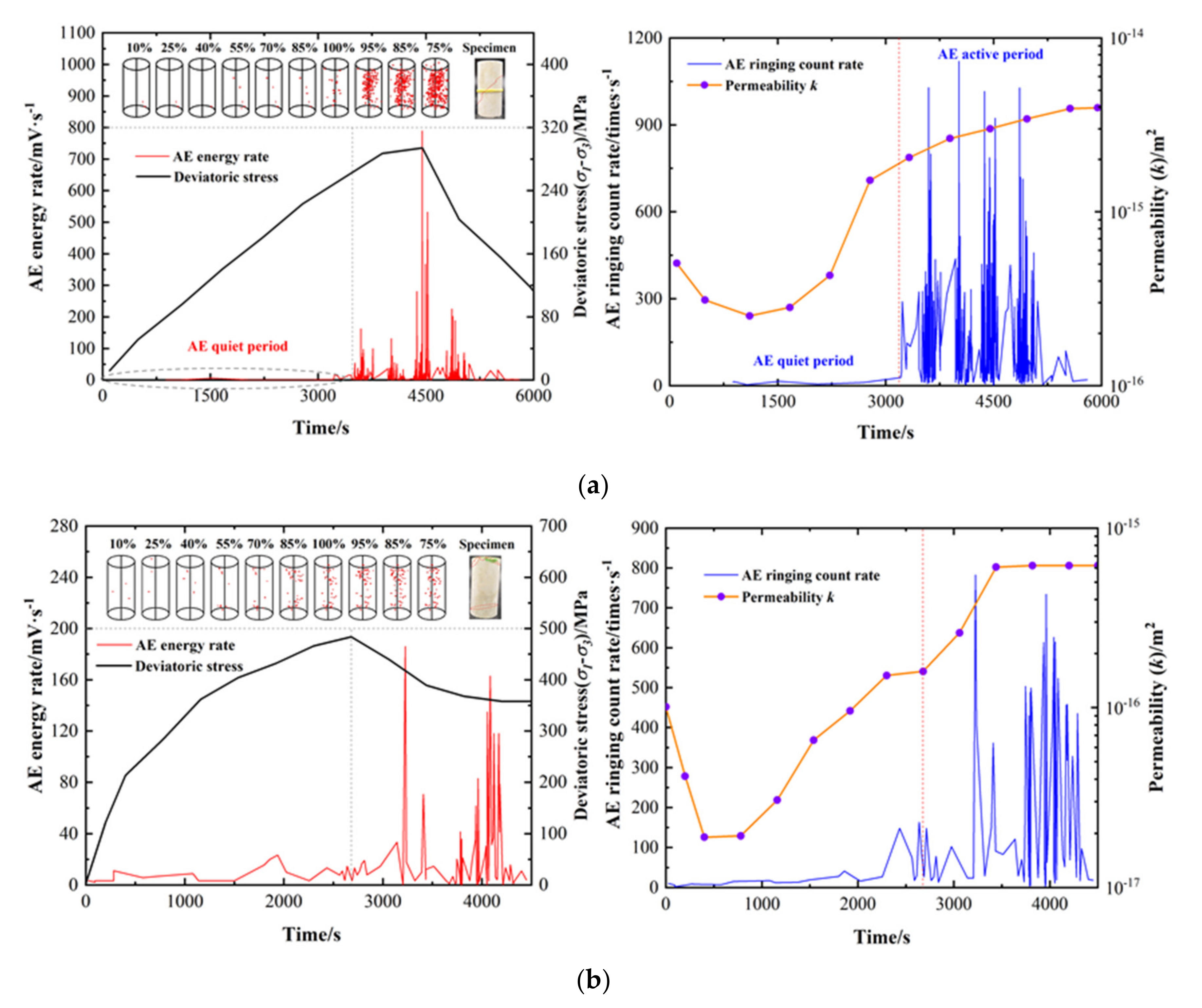Experimental Investigation on Permeability Evolution of Dolomite Caprock under Triaxial Compression
Abstract
:1. Introduction
2. Experiments
2.1. Specimen Preparation
2.2. Testing Apparatus and Methods
- The dolomite specimen was completely wrapped with shrink film and placed on the test platform. Then, we installed the axial extensometer and circumferential extensometer, closed the triaxial pressure chamber and installed the acoustic emission sensors outside. At last, the acoustic emission instrument was adjusted to the best condition;
- Filled the triaxial pressure chamber with hydraulic oil and applied the confining pressure to the target value (σ3 in Table 2). The confining pressure loading rate was set at 3 MPa/min;
- After the confining pressure loading was completed, nitrogen was injected into both ends of the sample by gas permeation equipment to stabilize the pressure difference between the upper and lower ends at 3 MPa. Then, a permeability test was conducted, and the permeability was taken as the initial permeability before axial loading;
- The axial loading was controlled by force and circumferential displacement, successively. Firstly, the specimen was loaded to the yield stress point at the rate of 30 kN/min, and then loaded to the residual stress stage at the circumferential displacement rate of 0.02 mm/min;
- During the axial loading process, permeability tests were carried out at different strain points, and at least 12 penetration tests were conducted during the whole loading process, including no fewer than eight times before the peak value, one time at the peak stress point and no fewer than three times after the peak value.
3. Experiment Results and Discussion
3.1. Permeability and Porosity under Hydrostatic Confining Pressure
3.2. Confining Pressure Effects on Mechanical Properties of Dolomite
3.3. Confining Pressure Effects on Permeability under Gas Solid Coupling
3.4. Confining Pressure Effects on Acoustic Emission Characteristics under Gas Solid Coupling
4. Conclusions
- (1)
- The relationship between the permeability and hydrostatic confining pressure of dolomite is an exponential function, and that between porosity and hydrostatic confining pressure is a power function. The functional relationship is obtained by experimental fitting; the permeability and porosity of dolomite decrease with the increase in hydrostatic confining pressure;
- (2)
- Within 60 MPa confining pressure, with the increase in confining pressure, dolomite specimens change from brittle deformation failure state to ductile deformation state, and the compressive strength increases gradually, confining pressure strengthens the compressive strength of dolomite. Furthermore, under the same confining pressure, the peak stress of conventional triaxial specimen is 10~30% higher than that of the gas–solid coupling specimen; the higher the confining pressure, the smaller the difference, and the residual stress is also the same, which indicates that the compressive strength of dolomite is weakened by gas permeation;
- (3)
- In the gas–solid coupling experiment, with the increase in confining pressure, the maximum permeability in the whole loading process gradually decreases. The maximum permeability under confining pressure of 15 MPa is 3.96 × 10−15 m2, while the maximum permeability under confining pressure of 30, 45, and 60 MPa is reduced to 2.29 × 10−15, 0.618 × 10−15, and 0.083 × 10−15 m2, respectively. This means that high confining pressure will inhibit the permeability of dolomite under critical confining pressure, which is consistent with the law obtained under hydrostatic confining pressure;
- (4)
- The higher the confining pressure is, the later the active period of AE occurs, as well as the lower AE energy rate and ring count rate. Concurrently, the fewer the AE event points and the lower the aggregation degree. This further shows that high lateral stress can more effectively inhibit the crack propagation and gas seepage of dolomite.
Author Contributions
Funding
Acknowledgments
Conflicts of Interest
References
- Zhang, Q.; Liu, J.F.; Wang, L.; Luo, M.; Liu, H.; Xu, H.; Zou, H. Impurity Effects on the Mechanical Properties and Permeability Characteristics of Salt Rock. Energies 2020, 13, 1366. [Google Scholar] [CrossRef] [Green Version]
- Ran, L.; Wu, Z.; Han, B. Utilization and development of salt caverns in the field of energy underground storage. Chin. J. Sci. Technol. Rev. 2013, 31, 76–80. [Google Scholar] [CrossRef]
- Liang, G.; Tian, Y.; Pu, H. Discussion on the development of underground gas storage technology in China. Chin. J. Gas Heat. 2014, 34, 1–6. [Google Scholar] [CrossRef]
- Dreyer, W.E. The Science of Rock Mechanics; Trans Tech Publications: Zurich, Switzerland, 1972. [Google Scholar]
- Dreyer, W.E. Results of Recent Studies on the Stability of Crude Oil and Gas Storage in Salt Caverns. In Proceedings of the Fourth International Symposium on Molten Salts, Houston, TX, USA, 3–6 June 1973; pp. 65–92. [Google Scholar]
- Ding, G.; Zhang, Y. Salt Cavern Underground Gas Storage; Petroleum Industry Press: Beijing, China, 2010. [Google Scholar]
- Bennion, B.; Bachu, S. Drainage and imbibition relative permeability relationships for supercritical CO2/brine and H2S/brine systems in intergranular sandstone, carbonate, shale, and anhydrite rocks. SPE Reserv. Eval. Eng. 2008, 11, 487–496. [Google Scholar] [CrossRef]
- Baud, P.; Schubnel, A.; Wong, T.F. Dilatancy, compaction, and failure mode in Solnhofen limestone. Int. J. Geophys. Res. 2000, 105, 19289–19303. [Google Scholar] [CrossRef]
- Gou, Y.; Wu, Z.; Qi, H. Assessment on the cap rock tightness of the gas storehouse of Anning salt cavern. J. China Well Rock Salt 2013, 44, 16–19. [Google Scholar]
- Zhuo, Q.; Zhao, M.; Li, Y. Dynamic sealing evolution and hydrocarbon accumulation of evaporite cap rocks: An example from Kuqa foreland basin thrust belt. Chin. J. Pet. 2014, 35, 847–856. [Google Scholar] [CrossRef]
- Chen, W.; Luo, P.; Shan, Y. Analysis of dolomite reservoir characteristics of Xiaoerbulak formation in sugetebulake area, Tarim Basin. Chin. J. Pet. Geol. Eng. 2010, 24, 12–15. [Google Scholar]
- Jiang, L.; Yu, D. Research on reservoir characteristics of Carboniferous Bioclast limestone member in Maigaiti Slope, Tarim Basin. Chin. J. Peking Univ. 2003, 39, 428–434. [Google Scholar] [CrossRef]
- Li, S.; Zhou, Y. Rock mechanic experiment study of evaluation on cap rock effectiveness. Chin. J. Pet. Geol. Exp. 2013, 35, 574–578. [Google Scholar] [CrossRef]
- Tillerson, J.R. Geomechanics Investigations of SPR Crude Oil Storage Caverns; Sandia Labs: Albuquerque, NM, USA, 1979. [Google Scholar]
- Hansen, F.D.; Mellegard, K.D.; Sensen, P.E. Elasticity and Strength of Ten Natural Rock Salt. In Proceedings of the First Conference on the Mechanical Behavior of Salt, State College, PA, USA, 9–11 November 1981; pp. 71–83. [Google Scholar]
- Hunsche, U. Fracture Experiments on Cubic Rock Salt Samples. In Proceedings of the First Conference on the Mechanical Behavior of Salt, State College, PA, USA, 9–11 November 1981; pp. 169–179. [Google Scholar]
- Hunsche, U.; Albrecht, H. Results of true triaxial strength tests on rock salt. Eng. Fract. Mech. 1990, 35, 867–877. [Google Scholar] [CrossRef]
- Ni, X. Characteristics and main controlling factors of the Cambrian pre-salt dolomite reservoirs in Tazhong Block, Tarim Basin. Int. J. Oil Gas Geol. 2017, 38, 489–498. [Google Scholar]
- Shao, L.; Han, J.; Ma, F. Characteristics of the Cambrian dolomite reservoirs and their facies-controlling in eastern Tarim Basin. Acta Sedimentol. Sinica 2010, 28, 953–961. [Google Scholar]
- Cuevas, C.D.L. Pore structure characterization in rock salt. Eng. Geol. 1997, 47, 17–30. [Google Scholar] [CrossRef]
- Peach, C.J. Influence of deformation on the fluid transport properties of salt rocks. Geol. Ultraiectina 1998, 27, 238–245. [Google Scholar]
- Tutolo, B.M.; Luhmann, A.J.; Kong, X.-Z.; Saar, M.O.; Seyfried, W.E. Experimental Observation of Permeability Changes in Dolomite at CO2 Sequestration Conditions. Environ. Sci. Technol. 2014, 48, 48. [Google Scholar] [CrossRef]
- Jiang, C.; Duan, M.; Yin, G.; Wang, J.; Lu, T.; Xu, J.; Zhang, D.; Huang, G. Experimental study on seepage properties, AE characteristics and energy dissipation of coal under tiered cyclic loading. Eng. Geol. 2017, 221, 114–123. [Google Scholar] [CrossRef]
- Guo, J.; Zou, Y.; Cheng, X. Study on acoustic emission characteristics and permeability variation of coal samples under cyclic loading. Chin. J. Coal Sci. Technol. 2018, 46, 105–109. [Google Scholar] [CrossRef]
- Butt, S. Development of an apparatus to study the gas permeability and acoustic emission characteristics of an outburst-prone sandstone as a function of stress. Int. J. Rock Mech. Min. Sci. 1999, 36, 1079–1085. [Google Scholar] [CrossRef]
- Kovari, K.; Tisa, A.; Einstein, H.H.; Franklin, J.A. Suggested methods for determining the strength of rock materials in triaxial compression: Revised version. Int. J. Rock Mech. Min. Sci. 1983, 20, 285–290. [Google Scholar] [CrossRef]
- Sutherland, H.; Cave, S. Argon gas permeability of new mexico rock salt under hydrostatic compression. Int. J. Rock Mech. Min. Sci. 1980, 17, 281–288. [Google Scholar] [CrossRef]
- Wladis, D.; Jonsson, P.; Wallroth, T. Regional Characterization of Hydraulic Properties or Rock Using Well Test Data; Swedish Nuclear Fuel and Waste Management Co.: Stockholm, Sweden, 1997. [Google Scholar]
- Alkan, H. Percolation model for dilatancy-induced permeability of the excavation damaged zone in rock salt. Int. J. Rock Mech. Min. Sci. 2009, 46, 716–724. [Google Scholar] [CrossRef]










| Specimen Number | Diameter D/mm | Height H/mm | Mass m/g | Density ρ/g·cm−3 | Initial Porosity ω/% | Initial Permeability K/mD |
|---|---|---|---|---|---|---|
| d-1 | 37.91 | 75.92 | 233.01 | 2.72 | 4.22 | 1.54 |
| d-2 | 38.09 | 76.01 | 232.75 | 2.69 | 4.67 | 1.98 |
| Test | Specimen Number | σ3/MPa | D/mm | H/mm | m/g | ρ/g·cm−3 | ω/% | K/mD |
|---|---|---|---|---|---|---|---|---|
| Conventional triaxial | d-3 | 15 | 38.00 | 76.05 | 233.30 | 2.71 | 4.20 | 1.53 |
| d-4 | 45 | 37.92 | 75.89 | 234.64 | 2.74 | 3.99 | 1.43 | |
| d-5 | 60 | 38.13 | 76.17 | 234.74 | 2.70 | 4.15 | 1.51 | |
| Gas–solid coupling | d-6 | 15 | 38.15 | 76.12 | 238.27 | 2.74 | 4.17 | 1.52 |
| d-7 | 30 | 38.09 | 76.16 | 239.80 | 2.76 | 4.09 | 1.48 | |
| d-8 | 45 | 37.98 | 75.94 | 237.49 | 2.76 | 4.05 | 1.46 | |
| d-9 | 60 | 38.11 | 76.08 | 238.21 | 2.74 | 4.12 | 1.50 |
Publisher’s Note: MDPI stays neutral with regard to jurisdictional claims in published maps and institutional affiliations. |
© 2020 by the authors. Licensee MDPI, Basel, Switzerland. This article is an open access article distributed under the terms and conditions of the Creative Commons Attribution (CC BY) license (http://creativecommons.org/licenses/by/4.0/).
Share and Cite
Xu, D.; Liu, J.; Wu, Z.; Wang, L.; Liu, H.; Xiao, F.; Zeng, Y.; Lyu, C. Experimental Investigation on Permeability Evolution of Dolomite Caprock under Triaxial Compression. Energies 2020, 13, 6535. https://doi.org/10.3390/en13246535
Xu D, Liu J, Wu Z, Wang L, Liu H, Xiao F, Zeng Y, Lyu C. Experimental Investigation on Permeability Evolution of Dolomite Caprock under Triaxial Compression. Energies. 2020; 13(24):6535. https://doi.org/10.3390/en13246535
Chicago/Turabian StyleXu, Deng, Jianfeng Liu, Zhide Wu, Lu Wang, Hejuan Liu, Fukun Xiao, Yin Zeng, and Cheng Lyu. 2020. "Experimental Investigation on Permeability Evolution of Dolomite Caprock under Triaxial Compression" Energies 13, no. 24: 6535. https://doi.org/10.3390/en13246535






